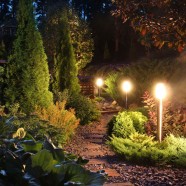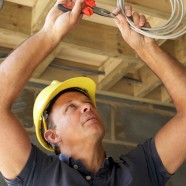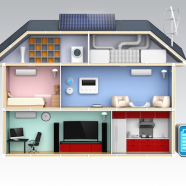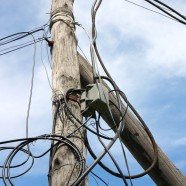How to Maintain Your Outdoor Landscape Lighting in Good Condition
Spot lighting and general area lighting are an attractive and important part of many landscape plans. Why put in elaborate trees and hedge designs if you can’t see them after dark? If you’ve decided to include landscape lighting in the plans for your property, set up an electrical maintenance schedule to keep your lights in good running order. Your residential electrical contractor can not only install all the outdoor light designs you want, he can tell you when your system needs maintenance during the year.
Visibility
Landscape lighting, by its nature, is set close to the ground and is vulnerable to damage from all landscaping machines such as lawnmowers and weed trimmers. Placing a set of green lights in the middle of the lawn might be a good design choice, but those lights aren’t likely to last long. They’ll fall victim to your lawnmower before the end of summer, most likely. Either choose a color that stands out from the lawn, such as black or a color to match your flowers, or put something around each light fixture that draws the eye. White wire fencing is inexpensive, light, and simple to install, yet you’ll see them from halfway across the yard. And lights that you see are less likely to be damaged.
Materials
The atmosphere in your environment makes a big difference when it comes to your ability to maintain landscape lighting. Some metal fixtures can corrode when installed in salt air, like the air that’s found in southeastern Florida. Although you may love the look of other metals, brass and copper are superior finishes for salt air. They may patina over time, but they’re meant to, and the change in color is a natural process that won’t affect your lights’ operating ability.
Dead Light
One of the simplest forms of electrical maintenance happens when a light bulb seems to blow out. Often, it’s not the bulb but the socket in which it’s placed. Unplug the lighting system to make sure no power is running through it, then take the top off the light. Replace the bulb with another one from the same string. If the bulb still won’t light, you probably have corrosion in the socket. Cut down an emery board until it’s small enough to fit into the slot where the bulb goes, and slide it up and down to file off any corrosion that may be built up on the contacts. When you replace the bulb and turn the power back on, the lights should work like normal.
Maintaining Lights
Your residential electrical contractor should come out twice a year for basic maintenance. He should change all the bulbs to prevent them from burning out at inopportune times. He’ll also spray a corrosion preventative compound to the base of the lamp to help prevent salt air and sprinkler moisture from corroding the light’s contacts. New corrosion preventative should be applied each time the lights are changed.
Electrical Outlet
One of the best ways to maintain your landscape lighting is to make sure it’s connected to a safe system. Since the outlet and plug for your lights will be outdoors in the elements and subject to rain, the plug should be connected to a GFCI outlet. If your home doesn’t have this available, have your electrical contractor install one at the same time the lights are installed, or as soon after as possible if you’re inheriting an older system.
Read MoreIncrease Energy Savings by Adding Passive Designs to Your Home
The best way to save money on energy is to not use it in the first place. Passive home designs take advantage of environments that are naturally thrifty when it comes to using energy, and incorporate them into the home. Areas that naturally use less power are cheaper to run, and usually easier to maintain. Even if you already have a home, it’s possible to retrofit passive design elements into your house in order to realize big energy savings, and a home renovation is the perfect time to consider installing some of these elements into your home design.
Landscaping
In environments such as South Florida where cooling is a much bigger issue than heating, keeping out the warmth is the largest use of power for most home HVAC systems. Houses stay naturally cooler inside if the warmth of the sun doesn’t hit the interior. One of the simplest ways to achieve this is by planting smart landscaping around any exposed windows, especially on the ground floor. Bamboo is notoriously fast-growing, and vines on lattice installations provide attractive coverage throughout the year. Both design ideas can shade out the worst of the hot sun in a small amount of time.
Insulation
Keeping your home insulated isn’t just for northerners who need to keep the heat inside against the winter chill. Florida homes need to keep the cool air inside, leaving as much heat outside as possible. Installing an upgrade on your home’s insulation during a home remodeling can help to keep the right environment inside your home, saving you power and money by lowering the need for air conditioning throughout the day. Look to your attic insulation as well as that in the walls when deciding on where your insulation dollars will do the most good.
Heat Distribution
One of the worst culprits for power usage is in rooms that gather and hold the heat. Having a system to distribute and spread the heat around throughout the house helps to keep energy costs low. After all, one extremely hot room in your house is enough for most air conditioning systems to kick on until that room has cooled. Add a series of ceiling fans through your house during your home remodeling. Your electrical contractor can easily add them to the design plan, and during a renovation is the ideal time to include a major addition such as large ceiling fans.
Solar Panels
There’s a reason they call it the Sunshine State. In Florida, the sun shines down for a portion of almost every single day. Passive solar energy panels are among the most intelligent additions you can add to your home, when looking for passive energy savings. Once they’re installed, you don’t have anything else you have to do in order to realize massive savings on your energy bills. Some users even create so much energy from their solar panels that they are able to sell power back to the energy company. Speak with a licensed electrical contractor to make a plan to install solar power panels on the roof of your home, garage, or other buildings. This one change alone can make enough difference to pay for itself in just a few years, giving you free power for years after that.
Read More5 Wiring Problems You Can Solve During a Home Renovation
Some electrical wiring problems aren’t dangerous, so they’re not worth tearing apart a room just to upgrade your system. They can be annoying, though, and they’re the perfect candidates for extra projects during a home renovation. Whether your electrical wiring is from your grandmother’s time, or it just got installed the last decade, it can be outmoded and ready for replacement if it’s causing problems. Work with your electrical contractor when planning your home rewiring job to include extra wiring problems you may have.
Lights Flickering When It’s Windy Outside
Unlike some of the annoying circumstances you can fix during a home rewiring bout, this one can actually be dangerous and should be taken care of as soon as possible. The spot where the power lines connect with your house is attached to a fixture. When the wind blows the line around and it rubs on the fixture, parts of the line can fray and cause small breaks in service. These small breaks can cause sparking and a fire hazard, especially during rain storms which is typically when high winds occur. Speak with your utility company. They’ll probably replace your fixture for free, although a home renovation is a good time to do this as you can coordinate your décor with the electrical work.
Too Few Outlets
If your family has grown, your need for electrical power has probably grown even quicker. A home renovation is the perfect time to add more electrical wiring for more outlets in each wall. Families have varied needs for extra outlets, such as:
- A home office with extra computers and printers
- Teenager’s rooms with televisions and stereos
- Outdoor kitchens on decks or patios
- Kitchens with lots of new small appliances
If you’re relying on multiple power strips and extension cords for your everyday life, it’s time to get an upgrade. Your electrical contractor can easily include extra outlets in your renovation plan, solving the problem of having to unplug some appliances before plugging in others.
No GFCIs Installed
GFCIs, or Ground Fault Circuit Interrupters, are designed to immediately turn the electricity off if the plugged-in item comes in contact with water or other types of moisture. These safety features are standard in bathrooms and kitchens, but if you’ve got an older home they may be missing from your rooms. It’s a very simple task for your electrician to switch out one type of outlet for another during a home rewiring job, but it’s crucial for your family’s safety, and may even be required for a renovation, depending on your particular city’s building codes.
Plugs Fall Out of Outlets
You plug in a lamp, and an hour later the plug is laying on the floor. No, you don’t have poltergeists; you just have an older electrical system in your house. Outlets should grip the end of the plug when it’s inserted into the holes. When the clip that’s designed to hold the plug wears out, it allows the plug to slip out and fall to the floor. Unfortunately, this situation can cause arcs, sparking, and a fire hazard. Have your contractor change these outlets as soon as possible.
Power Upgrade Needed
If you’re relying on fans to get through a Florida summer, your home probably needs a power upgrade. With the right type of wiring, adding an air conditioner can result in a surprising amount of energy savings in the long run, between the cold showers you avoid and the efficiency of today’s EnergyStar appliances. A home renovation is the perfect time to upgrade your circuit breaker and wiring, as well as installing new major
Read More5 Great Bathroom Lighting Ideas
When it comes to choosing rooms to remodel, bathrooms are always near the top of almost every homeowner’s list. Families grow, styles change, and fixtures seem to look dated quicker than in other parts of the house, so bathroom renovation is a natural choice after just a few years.
After you’ve decided on the bathtub and the color scheme, consider how lighting can become the final touch that brings the room together. Nothing completes a room like the right lighting scheme, and few decorating accents can do so much with such a small amount of effort and money.
Layer the Light
If your bathroom lighting consists of one fixture in the middle of the ceiling, you’re in desperate need of an upgrade. While a single ceiling light might give you enough light to shower by, it doesn’t do anything for the look of the room. Task lighting will give you layers of light while adding warmth to the space. Put in a light above the shower or bath, flank the dressing mirror with side lights, and even add tiny lights along the bottom of the wall to stand in for old-fashioned night lights.
Use Non-Traditional Lighting
A complete bathroom renovation calls for a complete rethinking on your lighting scheme. Why stick with traditional bathroom ceiling lights in your sleek new room? Consider other types of light sources to give your bathroom a unique designer look while lighting up the space. Try bean pot lamps or candlestick lights on a side table, hanging kitchen lights over the vanity, or small electric candles through the room for a soft, romantic glow.
Vanity Lighting
If your bathroom design doesn’t leave much room for dedicated vanity lighting, add light sconces directly onto the surface of the mirror. The mirror behind the lights will double the brightness, giving the room twice as much light in a very small space.
Lighting as Decor
Bathroom lighting doesn’t have to be a simple utility. When you choose the right fixtures, the lighting can become a crucial part of your bathroom design:
- Sleek, modern rooms look great with lots of chrome lamps and fixtures.
- If your design flair leans toward the funky, incorporate strings of rope lighting wound around the curtain rods.
- For a room that is romantic and ruffled, bring in some bedside lamps and candle sconces to continue the theme.
- If this bathroom is mainly for the kids, use lamps in bright primary colors, or check the bedroom department for colorful lamps with their favorite cartoon characters on them.
You may have to change things out as your (or the kids’) interest wanes, but then it will give you a good excuse to give the room a makeover.
Use Multiples
When it comes to bathroom lighting, if one is good, then many are better. Plan a design that includes multiples of all the lights you plan to install. Instead of one central light fixture, install three or five hanging bulbs with decorative shades on different lengths of cord. Group bunches of electric candles on the back of the toilet. Use multiple small bulbs around the vanity mirror instead of one or two smaller ones. More always looks rich and abundant, and it takes your room away from the cookie-cutter design look.
Some lighting changes are a snap to do on your own, but some require a licensed professional electrician to install them safely. When you speak with your electrical contractor and plan your bathroom renovation, let him know about the lighting designs you want to use so he can incorporate them into his renovation schedule.
Read MoreReasons to Choose Remote Monitoring for Your Standby Generator
People living in areas that are subject to frequent power outages (such as southeastern Florida) know the importance of having a standby generator installed in their home.
Between frequent lightning storms, older infrastructure, and the risk of tropical storms, all local homes can use a whole-home generator. But if your generator isn’t working when the power goes out, it’s a waste of space in your yard.
The best way to keep up with the state of your backup power supply is by using generator monitoring.
Testing
If you count on your standby generator for peace of mind during thunderstorms and power outages, you need to take every precaution to make sure it’s going to work when the power goes out.
How do you know when your whole-home generator is working correctly? Good generator monitors will test your unit weekly, turning it off and then on again. If anything is wrong the standby generator won’t go back on again, much like an electric light won’t go on if the circuit breaker has been tripped.
Once the monitor sends you a signal telling you that there’s a problem with the generator, you can repair it before the machine is needed during the next power outage.
Remote Alerts
Some generators give off an alarm when something is wrong, but if you’re not home, or if your air conditioning unit is too loud you may not hear anything before it’s too late.
With generator monitoring, the smart sensor on your machine checks on a regular basis, or checks constantly, and will send you a message if something is wrong.
You can choose to get a recorded phone call, a text message on your phone or an email, depending on the monitoring company you employ.
Fuel Level
You can monitor your system all day long, but if your power supply doesn’t have fuel it won’t work during a blackout. The fuel level in your standby generator is probably one of the last things you think to check every week, but you can have a monitor check it for you.
Some generators have level checks built in and you can have alerts sent to your phone or email. If your generator doesn’t include a fuel check, you can install one very easily, then synch it with your monitor. You’ll always have a full generator, and one less thing to have to worry about.
Vacation Peace of Mind
Installing a whole-home generator adds a great deal of peace of mind when you’re on vacation, but to be completely sure your home will still be in good shape when you come back, a monitor is best. If the power goes out while you’re in another state and the generator doesn’t go on, the message you receive can give you time to call a neighbor or friend to add fuel or remove your frozen food before you can get back home.
You can take your family on vacation secure in the knowledge that your belongings will be just as you left them when you get back.
Health Concerns
For most people, keeping the power on is a convenience issue, but for those with health problems it can be literally life or death:
- Diabetics who take insulin have to keep their supply in a cold storage place or it will go bad.
- Patients with breathing problems need to run CPAP machines or breathing treatments.
- Even electric carts and wheelchairs have to be recharged on a regular basis, making a standby generator a crucial element in day-to-day health care.
If you or your family members need electricity to keep yourself healthy, generator monitoring can be a crucial part of protecting your health.
Read MoreHow to Prevent Problems from Overloaded Circuits
It’s not likely that your house will catch on fire from one tripped circuit breaker, but frequently overloaded electrical circuits can become a dangerous situation if they’re not corrected. Power surges are common in Florida because of the frequent electrical storms in the area, and any circuit that’s running up to capacity is in danger of overloading every time lightning strikes in the area. Preventing problems with your electrical equipment is a matter of preparing ahead of time, then keeping up with the quality of your equipment rather than letting it fall into disrepair.
Audit Your Equipment
If you’ve been tripping circuit breakers or if you have lights that dim when the refrigerator comes on, you know where the problems are in your house. Not having these problems doesn’t mean your electrical equipment is perfectly fine, though. Circuits may be running just on the edge of their limits, and one storm or an extra appliance being plugged in can be just enough to push them over the edge.
If you don’t have a circuit map of your home, take the time to create one of your own. Turn one breaker off, then move through the house and see what lights, outlets, and equipment doesn’t work. Mark that area on the map and indicate what breaker it’s connected to, then move on to another breaker. Map out your entire house in this manner.
Go through each individual circuit and unplug any appliances that aren’t currently in use. If you make coffee once a day, unplug the pot when you’re ready to head out in the morning. Work all day long? You don’t need the television plugged in, draining power while you’re gone. From phone chargers to blow dryers, most houses have dozens of items plugged in and draining power. Lighten the load on your circuits by unplugging yours.
Upgrade Your Electrical Installation
The equipment in your house uses electrical services in the most efficient way it can, but if you’re overloading the system, it’s probably time to upgrade and replace your older electrical equipment. The most obvious clue that you need an upgrade is having an older house with a fuse box instead of circuit breakers. Call an electrical contractor to replace this immediately, as older fuse boxes are almost invariably worn out, creating a fire hazard in your home.
If you’re constantly having to unplug appliances just to plug something else in, or if you’re relying on power strips and extension cords as a permanent solution, you need an upgrade on wiring and outlets. Adding outlets in logical places depending on your electrical usage can help to spread the load, but you may need additional upgraded wiring if your usage is heavy in one part of the house such as an office with multiple computers and large monitors. Your contractor will test your lines and tell you if you need an upgrade.
Schedule Regular Maintenance Appointments
Electrical maintenance isn’t just for repairing problems once they’ve happened. The best and least expensive way to deal with electrical problems is to prevent them before they happen. Scheduling regular maintenance appointments with an electrical contractor will eliminate most of the problems you have with wiring and circuits in your home. An electrical contractor will check wiring for wear and excess usage, look for possible improvements in your system, suggest ways to save power, and replace any equipment that’s beginning to wear out. You schedule regular dental and medical checkups for yourself; give your home the same consideration and have your electrical contractor check your wiring a couple times a year.
Read More






Recent Comments